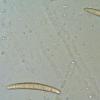
16-03-2014 22:00
Hello,I found this species a few months ago but ha

08-12-2025 13:39
Thomas Læssøehttps://svampe.databasen.org/observations/10572899

07-12-2025 16:07
Arnold BüschlenHallo, ich habe in einer Moos-Aufsammlung (epiohy

05-12-2025 17:33
 Bruno Coué
Bruno Coué
Bonjour, je serais heureux de recueillir votre avi

07-12-2025 09:24
De la pasada semana en Galicia EspañaEn el suelo

06-12-2025 00:19
 Viktorie Halasu
Viktorie Halasu
Hello, would anyone have this article, please? An
Karstenia spec?
Jac Gelderblom,
19-11-2011 17:37
J'ai trouvé, immergé dans une tige d'une ombellifère (probablement) , une petite asco avec hymenium grisatre. Seulement une trou était farce en ce material j'ai utilisé pour l'étide et faire des photo's. Je l'ai trouvé au rive du fleuve "Hollands Diep" au sud des Pays Bas.
Diamètre des trous: 0,35 - 0,45 mm
Dimensions des spores; 33-47 x 4,5 - 5,5 micron avec 5 septes.
Dimensions des asques: 130x 10 micron , ils prennent un couleur rouge dans Lugol.
Jái joint des photo's de la tige, des spores (dans l'eau et Lugol) et des asques (aussi dans l'eau et Lugol).
Je pense à une espece de Karstenia, mais je ne peux pas trouver une espece qui réunit les données ci dessus.
Il ya quelqe'un qui peut m'aider?
Amitiés
Jac Gelderblom
Jac Gelderblom,
19-11-2011 17:46
Re : Karstenia spec?
Comment on peut ajouter des photos?
Jac Gelderblom.
Jac Gelderblom.
Christian Lechat,
19-11-2011 19:11

Re : Karstenia spec?
Bonsoir,
pour ajouter des images téléchargez le document joint
pour ajouter des images téléchargez le document joint
Amitiés,
Christian?
Hans-Otto Baral,
20-11-2011 16:45

Re : Karstenia spec?
Cher Jac
I do not think that this is a Karstenia. I do not see the apothecium with its excipulum and marginal lobes. The red reaction in IKI could refer to the ascoplasm instead of the ascus wall. This you can easily verify: When placing a fragment (at best a section) of the fruitbody a minute in KOH (2-10%) and then remove the KOH with a drop of water and add IKI, then you should get a bright blue hymenium in Karstenia.
Zotto
I do not think that this is a Karstenia. I do not see the apothecium with its excipulum and marginal lobes. The red reaction in IKI could refer to the ascoplasm instead of the ascus wall. This you can easily verify: When placing a fragment (at best a section) of the fruitbody a minute in KOH (2-10%) and then remove the KOH with a drop of water and add IKI, then you should get a bright blue hymenium in Karstenia.
Zotto
Jac Gelderblom,
20-11-2011 21:05
Re : Karstenia spec?
Thank you Zotto, but I used the last piece of material in making my photgraphs.
So, it is impossible for me to do the test you proposed.
If it is not Karstenia, any idea which genus it might be?
Greetings Jac
So, it is impossible for me to do the test you proposed.
If it is not Karstenia, any idea which genus it might be?
Greetings Jac
Hans-Otto Baral,
20-11-2011 21:42

Re : Karstenia spec?
The fruitbodies are these black dots on your macro? I see foru of tem on the photo. They look disc-shaped, but my impression of your micros sound more like a pyreno?
Zotto
Zotto
Jac Gelderblom,
21-11-2011 12:17
Re : Karstenia spec?
Hi Zotto
You should not look at the 4 black dots but at the two "big" holes.
These hole have diameter ca 0,4 mm and in one of them I found a greyish hymenium (see drawing). Investigating this greyish fruitbody I found the asci etc. of my photographs.
It is perhaps possible that this greyish substance (fruitbody or not) is contaminated with some pyrenomycete; but I didn't notice any trace of a perithecium.
Greetings Jac
You should not look at the 4 black dots but at the two "big" holes.
These hole have diameter ca 0,4 mm and in one of them I found a greyish hymenium (see drawing). Investigating this greyish fruitbody I found the asci etc. of my photographs.
It is perhaps possible that this greyish substance (fruitbody or not) is contaminated with some pyrenomycete; but I didn't notice any trace of a perithecium.
Greetings Jac
Hans-Otto Baral,
21-11-2011 12:35

Re : Karstenia spec?
My first look was at these holes :-) and these indeed resemble a Cryptodiscus (not Karstenia). Anyhow I do not remember a Cryptodiscus with such spores, and also here the entire hymenium reacts hemiamyloid.
Zotto
Zotto

 ajouter-des-images-0001.jpg
ajouter-des-images-0001.jpg




